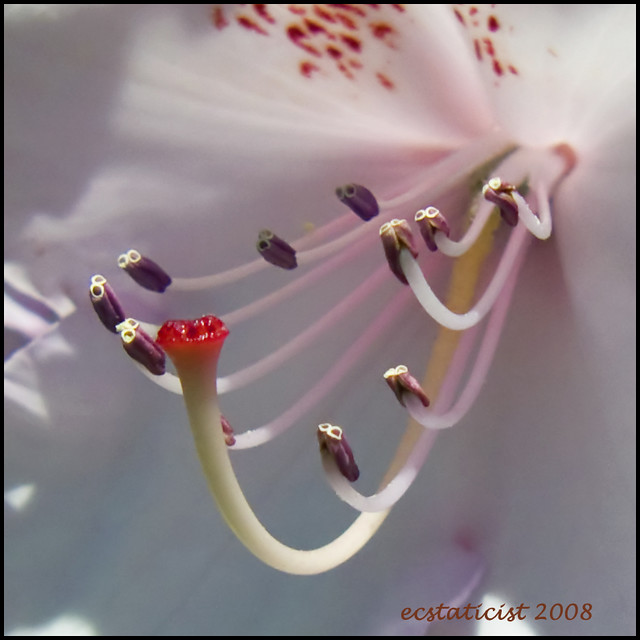Sowing satsuki azalea seeds
2 posters
Page 1 of 1
 Sowing satsuki azalea seeds
Sowing satsuki azalea seeds
This is not entirely bonsai related but some here may find it interesting. As an azalea hybridizer with a special love for satsuki cultivar I am currently sowing as many seeds as I can. Hopefully I can develop one or a handful of new cultivar several years down the road.
I just did an update on my site http://azaleasplendor.dyndns.info/
Here are some pictures:

And some of last years seedlings:

Some of the crosses I have sown seeds of are 'Reikou' x 'Juko', 'Alexander' x 'Hekisui' and 'Mary Helen' x 'Kozan'. Last years seeds were all related to 'Kirameki'.
I just did an update on my site http://azaleasplendor.dyndns.info/
Here are some pictures:

And some of last years seedlings:

Some of the crosses I have sown seeds of are 'Reikou' x 'Juko', 'Alexander' x 'Hekisui' and 'Mary Helen' x 'Kozan'. Last years seeds were all related to 'Kirameki'.
Glaucus- Member
 Re: Sowing satsuki azalea seeds
Re: Sowing satsuki azalea seeds
Interesting, I've always taken cuttings. Looks like fun. Can you describe the process to pollinate them and keep them pure?

Rob Kempinski- Member
 Re: Sowing satsuki azalea seeds
Re: Sowing satsuki azalea seeds
You should take cuttings to propagate them. They are hybrids and all seeds/seedlings will have an unique genetic makeup. The known cultivar are often 1 in a 1000 and superior to the average seedling. You sow as many seedlings as possible in the hopes of getting one really good one. That one is cloned/propagated through cuttings. And this way it can enter the nursery trade or end up as a popular bonsai cultivar. This is how most cultivar were developed. There's a few that may actually have been found in the wild. But in a sense that's similar. They are all special forms with special ornamental traits that need to be cloned to retain these traits.
Of course this hybridizing is how progress can be made and azalea with new traits can be developed. You harnass the power of evolution. And yes it is fun to develop your own varieties. At least I imagine it is. Can't wait to see the first flowers on my own seedlings.
The pollen of azalea is very sticky and stringy. It doesn't seem at all to spread by wind. Not all hybrids are equally fertile. But in many azalea flower closeup pictures you can see two white spots on the often darker anthers.
This is a good picture I just googled, not mine:

You can also see a bit of a shine on the stigma. This is because of a gluey mucus that probably helps with receiving the pollen.
Anthers are largely empty in that picture already. It seems for macro photographers azalea flower anatomy is a liked subject:
http://www.photomacrography.net/forum/viewtopic.php?t=7455
In my experience insects here seemed to ignore the satsuki hybrids are go after the brightly coloured kurume type azalea. Mostly bumblebees. I have heard people comment on ants going into the flowers and gathering the pollen.
Hybrids should be able to self pollinate. I hear species may have a way to block this.
My conclusion is that for my seed parents, pollen getting on the stigma without human help seemed quite impossible. On my kurume azalea of course the bumblebees went crazy on those flowers, speading around the pollen. But I never let those set seed anyway.
What I did was 'hand pollination' and not 'controlled pollination'. I just put a thick layer of pollen on the stigma and then attacked a pollen label. I did remove the stamen of the flowers that I pollinated. No need for 'bad' pollen to hang around once I had decided to pollinate that flower.
In the cases of amble pollen porduction, pulling out the stamen and pushing and rubbing it on the stigma of the selected seed parent did the job. The pollen is stringy and sticky so it will actually pull out a lot of pollen.
In the cases with limited pollen productions I collected some anthers, pul them in a smal cylinder and dried them a bit, shake the cylinder and see how much pollen you can collect with a set of tweezers. Then apply.
If 100% purity is the goal one has to put the plant in a greenhouse, break away the petals before the flower opens and before it produces pollen. Seal off the stigma. Then check when the stigma is receptive. Apply pollen and then seal it off again.
Contamination wasn't an issue for me. Lack of fertility often was. Of all the seeds I have labeled a pollen parent, some seeds are going to be contaiminated and thus mislabeled. But my guess is the percentage is low.
Of course this hybridizing is how progress can be made and azalea with new traits can be developed. You harnass the power of evolution. And yes it is fun to develop your own varieties. At least I imagine it is. Can't wait to see the first flowers on my own seedlings.
The pollen of azalea is very sticky and stringy. It doesn't seem at all to spread by wind. Not all hybrids are equally fertile. But in many azalea flower closeup pictures you can see two white spots on the often darker anthers.
This is a good picture I just googled, not mine:

You can also see a bit of a shine on the stigma. This is because of a gluey mucus that probably helps with receiving the pollen.
Anthers are largely empty in that picture already. It seems for macro photographers azalea flower anatomy is a liked subject:
http://www.photomacrography.net/forum/viewtopic.php?t=7455
In my experience insects here seemed to ignore the satsuki hybrids are go after the brightly coloured kurume type azalea. Mostly bumblebees. I have heard people comment on ants going into the flowers and gathering the pollen.
Hybrids should be able to self pollinate. I hear species may have a way to block this.
My conclusion is that for my seed parents, pollen getting on the stigma without human help seemed quite impossible. On my kurume azalea of course the bumblebees went crazy on those flowers, speading around the pollen. But I never let those set seed anyway.
What I did was 'hand pollination' and not 'controlled pollination'. I just put a thick layer of pollen on the stigma and then attacked a pollen label. I did remove the stamen of the flowers that I pollinated. No need for 'bad' pollen to hang around once I had decided to pollinate that flower.
In the cases of amble pollen porduction, pulling out the stamen and pushing and rubbing it on the stigma of the selected seed parent did the job. The pollen is stringy and sticky so it will actually pull out a lot of pollen.
In the cases with limited pollen productions I collected some anthers, pul them in a smal cylinder and dried them a bit, shake the cylinder and see how much pollen you can collect with a set of tweezers. Then apply.
If 100% purity is the goal one has to put the plant in a greenhouse, break away the petals before the flower opens and before it produces pollen. Seal off the stigma. Then check when the stigma is receptive. Apply pollen and then seal it off again.
Contamination wasn't an issue for me. Lack of fertility often was. Of all the seeds I have labeled a pollen parent, some seeds are going to be contaiminated and thus mislabeled. But my guess is the percentage is low.
Glaucus- Member
 Re: Sowing satsuki azalea seeds
Re: Sowing satsuki azalea seeds
Glaucus wrote:You should take cuttings to propagate them. They are hybrids and all seeds/seedlings will have an unique genetic makeup. The known cultivar are often 1 in a 1000 and superior to the average seedling. You sow as many seedlings as possible in the hopes of getting one really good one. That one is cloned/propagated through cuttings. And this way it can enter the nursery trade or end up as a popular bonsai cultivar. This is how most cultivar were developed. There's a few that may actually have been found in the wild. But in a sense that's similar. They are all special forms with special ornamental traits that need to be cloned to retain these traits.
Of course this hybridizing is how progress can be made and azalea with new traits can be developed. You harnass the power of evolution. And yes it is fun to develop your own varieties. At least I imagine it is. Can't wait to see the first flowers on my own seedlings.
The pollen of azalea is very sticky and stringy. It doesn't seem at all to spread by wind. Not all hybrids are equally fertile. But in many azalea flower closeup pictures you can see two white spots on the often darker anthers.
This is a good picture I just googled, not mine:
snip
..................
snip
Contamination wasn't an issue for me. Lack of fertility often was. Of all the seeds I have labeled a pollen parent, some seeds are going to be contaiminated and thus mislabeled. But my guess is the percentage is low.
Thanks for the explanation. Lots of fiddly work - wish you good results.

Rob Kempinski- Member
 Similar topics
Similar topics» Satsuki azalea
» Sowing seeds late in Florida.
» Styling Satsuki azalea
» Satsuki azalea
» Satsuki azalea
» Sowing seeds late in Florida.
» Styling Satsuki azalea
» Satsuki azalea
» Satsuki azalea
Page 1 of 1
Permissions in this forum:
You cannot reply to topics in this forum






